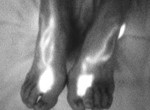Diagnosis of lymphedema
Diagnosis
Patients themselves or their family members are asked to observe the current state of lymphatic vessels while we explain the pathological condition to them. We can select more appropriate treatment methods and predict the effect of treatment by evaluating the lymphatic function.
Ultrasound examinations (upper limb, lower limb, genitalia, lower abdomen)
Conventional lymph scintigraphy and ICG fluorescence lymphography do not make it possible for us to determine the extent of lymphosclerosis, or how much a lymphatic vessel has been damaged. However, the latest technique using ultrasound can allow us to make a diagnosis of lymphosclerosis. We are now more likely than ever to identify better lymphatic vessels.
Lymph scintigraphy (upper limb, lower limb, genitalia, lower abdomen)
When radioactive isotopes (drugs that emit low radiation) are injected into the base of the fingers or toes, they are absorbed in the lymphatic vessels. The courses of systemic and deep lymphatic vessels or residual lymphatic function can then be analyzed. With concomitant use of indocyanine green fluorescence lymphography, we can understand the state of the patient's lymphedema in detail and propose the best treatment tailored to the pathological condition. It is possible to appropriately evaluate lymphatic function by taking several images at time intervals after the injections. Even people who are allergic to iodinated contrast media (contrast agents for CT scans) can undergo this scintigraphy.
ICG fluorescence lymphography (upper limb, lower limb, genitalia, lower abdomen)
When a green dye referred to as indocyanine green (ICG) is injected into the base of the fingers or toes, and so on, it is absorbed in the lymphatic vessels. This enables real-time analysis of the courses of superficial lymphatic vessels or residual lymphatic function. This examination is more sensitive than lymph scintigraphy, which makes it possible to reliably diagnose even early lymphedema associated with pain or tightness. It should be noted that people who are allergic to iodinated contrast agents must not undergo this lymphography.



